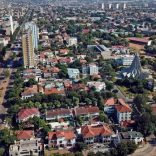Mozambique: France to finance doubling of Maputo-South Africa railway line - Watch
Mozambique: €1.8 million a month timber smuggling in Cabo Delgado ‘may be funding rebels’

Image: RTP
The authorities in Mozambique estimate that timber smuggling in Cabo Delgado province earns smugglers around 125 million meticais (€1.8 million) a month, and fear that it is funding the activities of the rebel groups that have been behind armed attacks in the area in recent years.
“Mozambique is a country with a vast forest cover of around 31,693,872 hectares, of which 25% are environmental conservation areas, with a great diversity of fauna and flora,” reads the National Terrorist Financing Risk Assessment Report. “In this sense, the sector is vulnerable to criminal activities that can easily be associated with terrorist financing.”
The document, to which Lusa had access on Monday, recognises that the level of vulnerability of the fauna, flora and fishery products sectors in the country to extremist financing is “medium high” and that the threat level of the sector is “high”.
“Illegally exploited resources have a high commercial value, with the biggest clients coming from Asia, driven by commercial appetites in search of raw materials. However, although there is no record of their direct links to terrorism, the fact that the smuggling of timber and other forest products takes place in areas with an active terrorist threat suggests that this activity has been a source of income for terrorists, since it is estimated that timber smuggling in Cabo Delgado is earning smugglers around 125 million meticais a month,” the report adds.
The document, which was finalised at the end of 2023, states that “the main vulnerabilities” of the sector were “the weak monitoring of conservation areas, as well as the weak monitoring capacity of the coast, especially in areas of active terrorist threat, which increases the risk of financing terrorism through illegal fishing, with a view to securing the logistical base of terrorists.”
It also states that the “quality of the sector’s controls” for terrorist financing in the country “is medium-low” and that the conservation areas have “a robust, up-to-date legal framework that responds adequately to international normative standards.”
However, it points out, “outside conservation areas and in areas where there is an active terrorist threat, monitoring is deficient and/or almost non-existent, but to this end it has relied on the collaboration of other actors (Defence and Security Forces).”
The report notes that “there is a very high number of suspicious activities that have been reported in the last three years.
“Although around 12,000 cases of suspicious activity reported and investigated in this period are related to money laundering, some of these cases are associated with terrorist financing, as they occurred in areas with an active terrorist threat,” it states.
As a result of supervision carried out, it adds, “administrative sanctions have been applied to various entities” but fines “are not paid” since “those sanctioned prefer to drag out their cases in the courts rather than comply with the sanctions” and that in the “application of criminal sanctions, the level is considered low,” given that of the 8,505 cases charged in 2022, “only 8.76% were tried and 0.35% convicted.”
It also identifies that the activity of cutting down forest and wildlife resources involves national and foreign citizens, “as intermediaries and agents, recruited by terrorists.”
The document recalls that environmental crimes in Africa “have become so sophisticated that they can be compared to drug and arms trafficking crimes” and cross borders, and that “various terrorist organisations on the continent have abused maritime resources, fauna and flora” to finance their activities.
“Somalia’s Al-Shabaab, for example, obtains funds by taxing charcoal and Uganda’s Lord’s Resistance Army relies heavily on poaching and the sale of ivory to obtain capital,” the report notes.












Leave a Reply
Be the First to Comment!
You must be logged in to post a comment.
You must be logged in to post a comment.